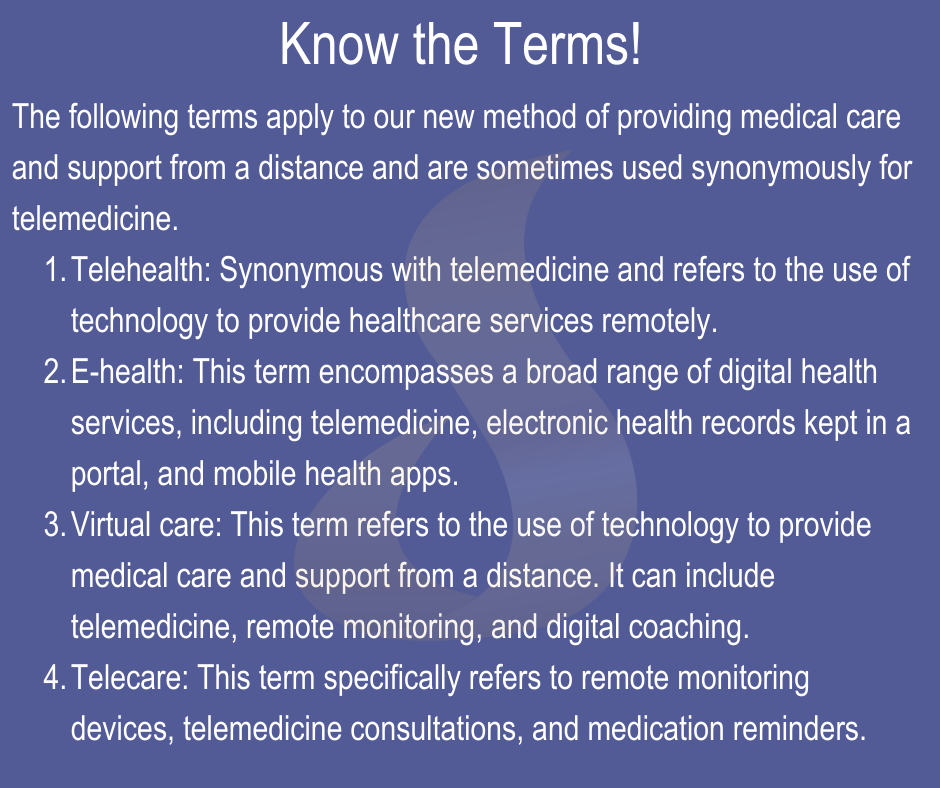What's On This Page?
ToggleTelemedicine has become an increasingly popular option for healthcare delivery in recent years. I urge you to embrace this method of care because it has the potential to revolutionize the way healthcare is delivered, making it more convenient for patients around the world.
According to a report by the Centers for Disease Control and Prevention, telemedicine usage increased by 154% between 2013 and 2018. A survey by the American Medical Association found that 28% of physicians used telemedicine to see patients in 2020, up from 14% in 2016
Today, I’d love to share information about telemedicine! It’s like a doctor’s appointment, but you get to wear your PJs and no one can judge you for it. Overall, telemedicine can be a great option for patients who need medical care but don’t want to deal with the challenges of getting to and from your doctor’s office. It’s not perfect, but it can be a good compromise between convenience and quality of care.
Know the Terms
Telehealth is a broader term that encompasses a wide range of healthcare services delivered through digital technology, including remote patient monitoring, teleconsultations, and educational programs. “Telemedicine,” on the other hand, typically refers specifically to virtual appointments and remote consultations.
While both terms are used interchangeably at times, “telehealth” has become more commonly used as a catch-all term for digital healthcare services, reflecting the wide range of services and tools available to healthcare practitioners and patients.

How a Typical Telemedicine Appointment Works
Scheduling: You, the patient, contact your healthcare provider to schedule a telemedicine appointment. If the clinic offers it, they will provide instructions on how to connect to the virtual appointment, usually through a secure video conferencing platform like Zoom, Skype, or Google Hangouts.
Connecting: At your appointment time, you log into the video platform using your computer, iPad (or tablet), or even a smartphone. If you turn your camera on and allow your microphone to access the app, you will see and hear your practitioner.
Consultation: Your doctor will conduct a consultation with you, similar to an in-person visit. Questions will be asked about your symptoms, current medications, and history.
Treatment: Depending on the diagnosis, your doctor might be able to prescribe medication, order some imaging studies, lab tests or recommend lifestyle changes. As for cost, in general, telemedicine appointments are less expensive than in-person visits, but it depends on the doctor. As for you, it’s definitely cheaper because you save on transportation costs, time off work and possibly babysitting fees if you have to leave your children at home.
Some of you may feel self-conscious about being on camera during your telehealth appointment, particularly if you have other family members around listening, or roommates. It’s also embarrassing to discuss personal or sensitive health issues in these cases. But you’re not alone.
There’s always some degree of nervousness or discomfort when trying new things, and telehealth is no exception. If you can find a private place, or schedule it when you’re alone, it will alleviate these concerns. As for lab tests, I’m not sure if you know this but you can order your own bloodwork nowadays. To learn more read my article, You Can Order Your Own Bloodwork and Lab Tests.
Here are the benefits and challenges pros of telemedicine for patients:
4 Pros of Telemedicine:
- Convenience: You don’t have to leave your house or office, which means no traffic, no parking, and no waiting room full of sick people who are probably sneezing on everything.
- Comfort: As I mentioned before, you get to wear your comfiest clothes, and you can snuggle up in your own bed or couch while you’re talking to the doctor. Plus, you don’t have to worry about catching any germs from a clinic.
- Efficiency: Telemedicine appointments tend to be shorter than in-person appointments because there’s less small talk and less time spent waiting. Plus, you don’t have to take time off work or rearrange your schedule as much.
- Accessibility: If you live in a remote area or have mobility issues, telemedicine can be a great way to get medical care without having to travel far or deal with transportation issues.
4 Cons of Telemedicine
- Technology: If you’re not tech-savvy, telemedicine can be a bit of a headache. You have to make sure your device is compatible, you have a good internet connection, and you know how to use the software. Plus, if there are any technical glitches during the appointment, it can be frustrating.
- Limited physical exam: Some things just can’t be diagnosed or treated through a video call. The doctor can’t touch you, obviously, so they might not be able to tell if you have a fever, for example. This can limit the accuracy of the diagnosis.
- Privacy concerns: If you’re doing the appointment from home, you might not have a private space where you feel comfortable discussing personal health issues.
- Insurance coverage: Some insurance plans don’t cover telemedicine appointments, so it may be out of pocket.

But What About Private Parts?
Some physicians require in-person examinations for a good reason… I’m thinking of a proctologist, urologist, or gynecologist. Can you imagine doing a pap smear or a prostate exam via telemedicine? I sure can’t!
Let’s start with the pap smear. This is a test that checks for abnormal proliferation of cells that line the cervix. So, how can you do that through a computer screen? Unless you have a magical, self-examining cervix that can just pop up on the screen for the doctor to take a look at, it’s just not possible. You might as well try to diagnose your own pap smear by using a Magic 8-ball!
And as for the prostate exam, well, let’s just say that some things are better left to a urologist. It’s uncomfortable enough to do it in person, how much worse could it get if you did it through a screen? I mean, I suppose you could try to perform a self-prostate exam with a long stick and a mirror! But hey, at least you don’t have to deal with the awkward small talk with doc during the examination!!!
So as you can see, it seems that some medical procedures just can’t be done through telemedicine. All kidding aside, telemedicine may not be able to fully replace in-person exams for some conditions. Providers may not be able to perform certain physical exams or tests through a video call, which can limit the accuracy of diagnoses. A study published in the Journal of the American Academy of Dermatology found that telemedicine was less accurate than in-person exams for diagnosing skin conditions.
Studies Have Been Conducted on Telemedicine
- A study published in the Journal of Medical Internet Research found that telemedicine was associated with improved access to specialty care for patients in rural areas. This allows for more privacy.
- A study published in the Journal of Telemedicine and Telecare found that telemedicine was associated with lower costs for patients and healthcare providers compared to in-person care for certain conditions. This improves access.
- A meta-analysis published in the Journal of Telemedicine and Telecare found that telemedicine was associated with improved outcomes for patients with heart failure. This helps Improves patient outcomes.
- A study published in the Journal of General Internal Medicine found that telemedicine was associated with improved efficiency and patient satisfaction in a primary care setting. This is super convenient.
History of Telemedicine
Telemedicine became popular during the pandemic, but it has actually been around for several decades. The concept dates back to the mid to late 1800s when doctors used telegraphs and radios to talk with each other and with people who got sick in remote locations. Since then, telemedicine has evolved to include video conferencing and mobile apps.
Many countries around the world have been using telemedicine for years. For example, it’s popular in Canada, the United Kingdom, and Australia. Did you know that telehealth has been used to provide medical care in some of the most extreme environments on Earth?
Studies on Telehealth
A research article I found on PLOS ONE determined that telehealth was an effective and cost-effective way to manage chronic obstructive pulmonary disease (COPD) in rural areas. The study found that telehealth interventions were associated with improved outcomes and lower costs compared to in-person care.
Another study found that telehealth was an effective way to deliver mental health services to children and adolescents. The interventions improved outcomes and high patient satisfaction.
Overall, there is a growing body of research on telehealth that supports its effectiveness and potential to improve access to medical care for patients in a variety of settings. As technology continues to evolve, it is likely that telehealth will become an even more important part of healthcare delivery around the world.
Is it Cost-Effective?
The cost of telemedicine appointments can vary widely depending on the provider and the type of service. A survey by the National Business Group on Health found that the average cost of a telemedicine visit was $79 US dollars in 2020.
Telemedicine may be less expensive than in-person care for certain conditions. A study published in the Journal of Telemedicine and Telecare found that telemedicine was associated with lower costs for patients and healthcare providers compared to in-person care for certain conditions.
Some insurance plans cover telemedicine visits, but coverage varies widely. Check with your individual plan. A study published in Health Affairs found that 31 states actually had laws mandating telemedicine coverage in private insurance plans in 2019, but the scope of coverage varied widely.
For Practitioners Only…
If you’re a practitioner interested in starting telemedicine services, the following information will help you. There are many different video conferencing platforms that can be used for telemedicine appointments, and you may choose to use different platforms depending on your patient’s ability to connect, or their specific preferences. Regardless of the platform used, it is important for patients and providers to ensure that they are using a secure and HIPAA-compliant platform to protect patient privacy and confidentiality.
In addition to Zoom and Skype, the most popular platforms, there are other video conferencing options that you may want to think about:
–>Doxy.me: This platform is designed specifically for telemedicine and offers secure video conferencing for healthcare providers and patients.
–>Google Meet: This platform is part of the Google Suite of tools and offers video conferencing capabilities for both personal and professional use.
–>Webex: This platform is owned by Cisco and offers video conferencing, screen sharing, and other collaboration tools for businesses and healthcare providers.
–>Facetime: This video calling app is available on Apple devices and can be used for telemedicine appointments with healthcare providers who also use Apple devices. There are several organizations that healthcare providers can turn to for guidance to learn how to implement telehealth/telemedicine services. Here are a few organizations. I hope they help you get started:
Practitioners may wish to seek out information from the following organizations:
The American Telemedicine Association (ATA): The ATA is a professional organization that promotes the use of telehealth to improve healthcare delivery. The ATA provides resources and support for healthcare providers looking to implement telehealth services, including guidelines for best practices and educational materials.
The Center for Connected Health Policy (CCHP): The CCHP is a non-profit organization that provides policy analysis and advocacy on telehealth issues. The CCHP offers resources and guidance for healthcare providers looking to navigate the complex regulatory landscape surrounding telehealth.
The National Consortium of Telehealth Resource Centers (NCTRC): The NCTRC is a network of 12 regional resource centers that provide support and resources for healthcare providers looking to implement telehealth services. The NCTRC offers technical assistance, educational programs, and other resources to help healthcare providers navigate the complexities of telehealth.
These organizations provide a wealth of resources, guidance, and support for healthcare providers looking to implement telehealth services. By leveraging the expertise and resources of these organizations, healthcare providers can ensure that their telehealth services are effective and provide high-quality care to their patients.
Summary
Telemedicine is a revolutionary approach to healthcare delivery that allows you to receive medical care and support from anywhere in the world using apps and digital technology. From virtual appointments to remote consultations, telemedicine has made it easier for people to access good medical care regardless of location, disabilities, mobility issues, or transportation challenges.
One of the greatest benefits of telemedicine is its ability to provide you with a high level of care, even for chronic conditions and mental health issues. By using telemedicine to monitor patients remotely and offer support and treatment, doctors can manage things more routinely, check in more often, and hopefully reduce the risk of complications.
Telemedicine is not without its challenges, however. Limited broadband access in some areas, legal and regulatory barriers, and patient privacy concerns are all obstacles that must be addressed in order to fully realize the potential of telemedicine.
Also, some people are just not able to connect or download an app, activate their camera or microphone, or overcome other challenges associated with using Zoom or other video conferencing platforms. I’m thinking of my 89-year-old mom! Telemedicine has the potential to revolutionize healthcare delivery and make quality medical care more accessible to patients around the world.
Overall, telemedicine is a powerful tool that has transformed the healthcare industry and improved the lives of patients everywhere. By embracing telemedicine we can stay healthier and keep it convenient. I think it creates a world where quality medical care is available to many more people who might otherwise not be able to access a doctor.
Thanks for reading my blog today on telemedicine. If you feel I’ve missed something, or you’d like to add a comment, email me at scriptessentials@gmail.com.

Suzy Cohen, has been a licensed pharmacist for over 30 years and believes the best approach to chronic illness is a combination of natural medicine and conventional. She founded her own dietary supplement company specializing in custom-formulas, some of which have patents. With a special focus on functional medicine, thyroid health and drug nutrient depletion, Suzy is the author of several related books including Thyroid Healthy, Drug Muggers, Diabetes Without Drugs, and a nationally syndicated column.


